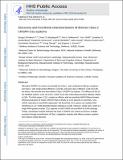| dc.contributor.author | Shmakov, Sergey | |
| dc.contributor.author | Makarova, Kira S. | |
| dc.contributor.author | Wolf, Yuri I. | |
| dc.contributor.author | Semenova, Ekaterina | |
| dc.contributor.author | Minakhin, Leonid | |
| dc.contributor.author | Severinov, Konstantin | |
| dc.contributor.author | Koonin, Eugene V. | |
| dc.contributor.author | Abudayyeh, Omar Osama | |
| dc.contributor.author | Gootenberg, Jonathan S | |
| dc.contributor.author | Joung, Julia | |
| dc.contributor.author | Konermann, Silvana M | |
| dc.contributor.author | Zhang, Feng | |
| dc.date.accessioned | 2017-12-13T14:25:36Z | |
| dc.date.available | 2017-12-13T14:25:36Z | |
| dc.date.issued | 2015-10 | |
| dc.date.submitted | 2015-09 | |
| dc.identifier.issn | 1097-2765 | |
| dc.identifier.issn | 1097-4164 | |
| dc.identifier.uri | http://hdl.handle.net/1721.1/112723 | |
| dc.description.abstract | Microbial CRISPR-Cas systems are divided into Class 1, with multisubunit effector complexes, and Class 2, with single protein effectors. Currently, only two Class 2 effectors, Cas9 and Cpf1, are known. We describe here three distinct Class 2 CRISPR-Cas systems. The effectors of two of the identified systems, C2c1 and C2c3, contain RuvC-like endonuclease domains distantly related to Cpf1. The third system, C2c2, contains an effector with two predicted HEPN RNase domains. Whereas production of mature CRISPR RNA (crRNA) by C2c1 depends on tracrRNA, C2c2 crRNA maturation is tracrRNA independent. We found that C2c1 systems can mediate DNA interference in a 5'-PAM-dependent fashion analogous to Cpf1. However, unlike Cpf1, which is a single-RNA-guided nuclease, C2c1 depends on both crRNA and tracrRNA for DNA cleavage. Finally, comparative analysis indicates that Class 2 CRISPR-Cas systems evolved on multiple occasions through recombination of Class 1 adaptation modules with effector proteins acquired from distinct mobile elements. | en_US |
| dc.description.sponsorship | National Institute of Mental Health (U.S.) (Grant 5DP1-MH100706) | en_US |
| dc.description.sponsorship | National Institute of Mental Health (U.S.) (Grant 1R01-MH110049) | en_US |
| dc.description.sponsorship | National Institute of Diabetes and Digestive and Kidney Diseases (U.S.) (Grant 5R01DK097768-03) | en_US |
| dc.description.sponsorship | National Institutes of Health (U.S.) (Grant GM10407) | en_US |
| dc.publisher | Elsevier | en_US |
| dc.relation.isversionof | http://dx.doi.org/10.1016/J.MOLCEL.2015.10.008 | en_US |
| dc.rights | Creative Commons Attribution-NonCommercial-NoDerivs License | en_US |
| dc.rights.uri | http://creativecommons.org/licenses/by-nc-nd/4.0/ | en_US |
| dc.source | PMC | en_US |
| dc.title | Discovery and Functional Characterization of Diverse Class 2 CRISPR-Cas Systems | en_US |
| dc.type | Article | en_US |
| dc.identifier.citation | Shmakov, Sergey et al. “Discovery and Functional Characterization of Diverse Class 2 CRISPR-Cas Systems.” Molecular Cell 60, 3 (November 2015): 385–397 © 2015 Elsevier | en_US |
| dc.contributor.department | Massachusetts Institute of Technology. Department of Biological Engineering | en_US |
| dc.contributor.department | McGovern Institute for Brain Research at MIT | en_US |
| dc.contributor.mitauthor | Abudayyeh, Omar Osama | |
| dc.contributor.mitauthor | Gootenberg, Jonathan S | |
| dc.contributor.mitauthor | Joung, Julia | |
| dc.contributor.mitauthor | Konermann, Silvana M | |
| dc.contributor.mitauthor | Zhang, Feng | |
| dc.relation.journal | Molecular Cell | en_US |
| dc.eprint.version | Author's final manuscript | en_US |
| dc.type.uri | http://purl.org/eprint/type/JournalArticle | en_US |
| eprint.status | http://purl.org/eprint/status/PeerReviewed | en_US |
| dc.date.updated | 2017-12-13T13:48:06Z | |
| dspace.orderedauthors | Shmakov, Sergey; Abudayyeh, Omar O.; Makarova, Kira S.; Wolf, Yuri I.; Gootenberg, Jonathan S.; Semenova, Ekaterina; Minakhin, Leonid; Joung, Julia; Konermann, Silvana; Severinov, Konstantin; Zhang, Feng; Koonin, Eugene V. | en_US |
| dspace.embargo.terms | N | en_US |
| dc.identifier.orcid | https://orcid.org/0000-0002-7979-3220 | |
| dc.identifier.orcid | https://orcid.org/0000-0001-6656-5002 | |
| dc.identifier.orcid | https://orcid.org/0000-0001-7915-1685 | |
| dc.identifier.orcid | https://orcid.org/0000-0003-2782-2509 | |
| mit.license | PUBLISHER_CC | en_US |
| mit.metadata.status | Complete | |
